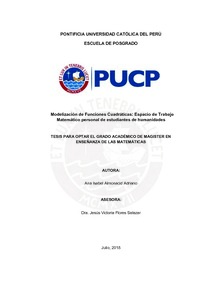Modelización de funciones cuadráticas: espacio de trabajo matemático personal de estudiantes de humanidades
Abstract
La investigación que se presenta surge de identificar la dificultad que los estudiantes
de carreras profesionales de humanidades tienen al resolver problemas de
modelización que movilizan la noción función cuadrática. Estas dificultades están
relacionadas a que la enseñanza de este concepto prioriza el manejo algebraico, ello
no permite la comprensión de la naturaleza de la función cuadrática en el sentido
relacional, variacional y de comportamiento. Comprensión que los estudiantes de
carreras de humanidades requieren para identificar, interpretar modelos cuadráticos
presentes en investigaciones de esas áreas, modelos matemáticos como los
relacionados a las ciencias de la comunicación, predicción de justicia criminal y
modelos usados en ciencias políticas. Esta necesidad está reflejada en los planes de
diversas universidades peruanas, entre públicas y privadas. A partir de esta
problemática el objetivo de nuestra investigación es analizar el Espacio de Trabajo
Matemático Personal de estudiantes de humanidades cuando movilizan el concepto
de función cuadrática al resolver tareas de modelización con el uso de tecnología
digital. Para ello, nos basamos en el constructo teórico del Espacio de Trabajo
Matemático desarrollado por Kuzniak y la tarea de modelización que se plantea sigue
la estructura del ciclo de modelización de Blum y Leiβ. Como metodología se recurre
a aspectos de la ingeniería didáctica de Artigue. Con respecto a la parte experimental,
la investigación se realiza con estudiantes que cursan el primer ciclo de carreras de
humanidades, estudiantes de entre 16 y 18 años. La tarea de modelización está
compuesta de tres fases. La actividad que desarrollan los estudiantes al resolver la
tarea propuesta permite identificar la activación de las génesis instrumental y
semiótica, además admite establecer los paradigmas priorizados por los estudiantes.
En base a esta investigación se concluye que las actividades desarrolladas por los
estudiantes de primer ciclo de carreras de humanidades evidencian la activación del
plano semiótico-instrumental. The research presented arises from identifying the difficulty that students of
professional careers in the humanities have when solving modeling problems that
mobilize the notion of quadratic function. These difficulties are related to the fact that
the teaching of this concept prioritizes algebraic management; this does not allow the
understanding of the nature of the quadratic function in the relational, variational and
behavioral sense. Understanding that students of humanities careers require to
identify, interpret quadratic models present in research in those areas, mathematical
models such as those related to communication sciences, prediction of criminal justice
and models used in political science. This need is reflected in the plans of various
Peruvian universities, between public and private. Based on this problem, the objective
of our research is to analyze the Personal Mathematical Workspace of humanities
students when they mobilize the concept of a quadratic function when solving modeling
tasks with the use of digital technology. For this, we rely on the theoretical construct of
the Mathematical Workspace developed by Kuzniak and the modeling task that follows
is the structure of the Blum and Leiβ modeling cycle. As a methodology, aspects of
Artigue didactic engineering are used. With respect to the experimental part, the
research is carried out with students who attend the first cycle of humanities careers,
students between 16 and 18 years of age. The modeling task is composed of three
phases. The activity that the students develop when solving the proposed task allows
to identify the activation of the instrumental and semiotic genesis, besides admits
establishing the paradigms prioritized by the students. Based on this research, it is
concluded that the activities developed by the students of the first cycle of humanities
careers demonstrate the activation of the semiotic-instrumental plane.
Temas
Matemáticas--Estudio y enseñanza
Funciones (Matemáticas)
Educación superior--Investigaciones
Funciones (Matemáticas)
Educación superior--Investigaciones
Para optar el título de
Maestro en la enseñanza de las Matemáticas
Collections
The following license files are associated with this item:






